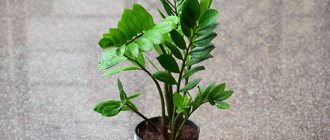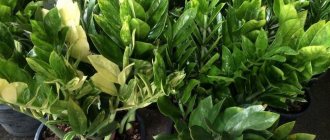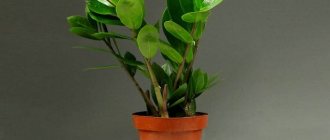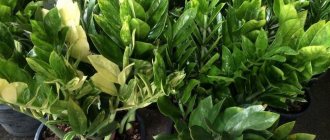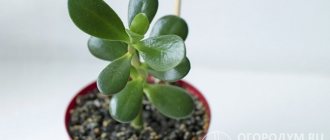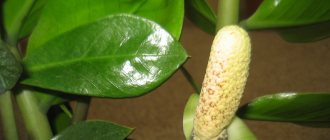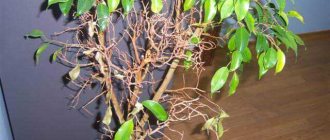Zamioculcas is an ornamental plant that belongs to the Araceae family. This exotic plant comes from tropical Africa. The second name for Zamioculcas is dollar tree.
Among flower growers it is believed that this plant is unpretentious in care and “turns green even if you forget about it.” But if, in addition to proper care, you fertilize the soil for the dollar tree in a timely manner and correctly, it will grow for many years. About what kind of fertilizer there is for this tropical shrub, how to fertilize and when it is necessary to fertilize - all this information will be in this article.
Rules for caring for Zamioculcas
The dollar tree comes from Africa, so the best location for it is the south side of the room. For normal growth it needs diffused light. In summer you can take the flower outside. You should avoid direct sunlight, which can cause burns on the leaves.
Dollar tree is an unpretentious houseplant
Since the tree is capable of accumulating water, it should be watered abundantly, but not often. The pan should remain dry; the next watering should be done only after the earthen clod has dried.
As a rule, in winter it is enough to water once a week, in summer more often. Water should stand for 12 hours before watering.
Important! Excess moisture can lead to yellowing of leaves, root rot and plant death. Therefore, before the next watering, you should make sure that the soil is sufficiently dry, and that after watering there is no excess moisture left in the pan.
The soil for the flower must be well-drained. A mixture suitable for cacti and succulents. Or you can mix turf soil, sand, leaf soil, peat and sphagnum moss. A quarter of the pot should be drainage. The money tree does not like clay soil, as it accumulates excess moisture, which is dangerous for the plant.
Instead of regular spraying, Zamioculcas should be washed from dust in the shower from time to time. However, if the air is extremely dry, the plant should still be sprayed periodically.
Features of Zamioculcas fertilizer
Feeding a dollar tree is not particularly difficult. But often it is precisely this that becomes the “stone” that even experienced indoor plant lovers stumble over. To understand why this happens at home, you need to get at least a general idea of the culture.
What do you feed zamioculcas?
Specialized fertilizers
41.25%
Folk remedies
58.75%
Zamioculcas is a succulent that has powerful, succulent, compound-pinnate leaves with thickening at the base. The segment-bearing rachis (axis) is often mistaken for a shoot. Young specimens barely reach 10-20 cm; adults, with proper care and successful placement, eventually reach 1 m, and sometimes more.
Zamioculcas is native to the rocky wastelands of Zanzibar, Madagascar and mainland East Africa. There are very few nutrients there. However, there are enough of them for the plant to grow and reproduce.
If you really want to tie the culture to familiar flowers, then you need to compare Zamioculcas not with its closest relatives - representatives of the Araceae family, Monstera, Dieffenbachia, Anthurium. In terms of care requirements, including soil composition and fertilization, it is closer to desert cacti.
A feature of culture is slow development. Flower growers want to spur growth and begin to intensively feed Zamioculcas, as a result of which it dies. In fact, fertilizers mean little to increase shoots, or rather leaves, the main thing here is to provide suitable conditions.
The importance of fertilizing and signs of nutrient deficiency
Nutrient deficiency affects, first of all, the appearance of the plant.
Nutrient deficiency affects the appearance of the plant
The flower signals the need for feeding:
- yellowing, wilting or falling leaves;
- the formation of spots on the leaves;
- throwing out shoots.
During the growing season (spring-summer), the tree is fed twice a month. This is a period of active growth when additional supply of nutrients is extremely important. While in winter the tree is at rest, so it does not need feeding.
When to fertilize
If all the basic conditions for caring for zamioculcas are met, the following signs can be used to understand that it urgently needs to be fed:
- shoots stretch out;
- leaves turn yellow;
- leaves dry out and fall off;
- dark spots appear on them.
Important: only the lower leaves of a tree that have turned yellow are considered normal. This means that the leaf ends its life cycle. This does not require any intervention.
Without feeding, the shrub's appearance will gradually deteriorate. In addition, the shrub will noticeably slow down its growth, although it already grows very slowly.
Types of Fertilizers for Dollar Trees
To feed Zamioculcas, special fertilizers for cacti and succulents are suitable, in addition, you can use universal formulations. The mixture must be introduced into moist soil. All universal fertilizers, as a rule, are diluted in a slightly higher proportion than for flowering plants.
In addition, experienced gardeners advise foliar feeding - spraying plants with fertilizers at the rate of 1 gram per liter of water.
Important! It should be noted that you can only spray a healthy flower, without signs of wilting, no more than once every 2 weeks. During the flowering period, fertilizing is not performed.
Mineral and organic fertilizers are suitable for Zamioculcas, which must be alternated every two weeks.
Dollar Tree Fertilizers
Most often used:
- "Agricola" is a fertilizer with a balanced composition of nitrogen, potassium and phosphorus. For root feeding, the calculation is 1 teaspoon per 2 liters of water. Do not mix with other substances. When using, try to avoid contact with plant leaves.
- "Agricola-Aqua" is already on sale in ready-made liquid form. Has a beneficial effect on growth and long-lasting flowering.
- "Pokon" - suitable for all succulents. Produced ready-made. Stimulates plant growth and flowering.
- “Good Power” – it contains succinic acid, which is a growth stimulant. Helps strengthen the flower's immunity.
- “Master Color” is a universal fertilizer rich in iron. Stimulates flowering and helps prevent plant chlorosis.
Care must be taken with all fertilizers. Not only can they be toxic to humans, but excess and high concentrations can kill the plant.
How often should you replant?
Obviously, thanks to its “solid” appearance, it came from distant East Africa and received the name dollar tree. Among lovers of “flower myths” there is a belief that the presence of zamioculcas in the house helps improve the financial well-being of its owners
It is all the more important in this case to maintain the good condition of the flower.
The dollar tree is a slow-growing succulent (it accumulates moisture in its fleshy leaves and then uses it up over a long period). Usually, after purchase, the plant needs to be replanted in high-quality soil, since the substrate used for sale is not designed for long-term use.
If the flower pot was chosen incorrectly in size and the zamioculcas roots are cramped in the existing container, an unscheduled transplant is needed with the selection of a larger container. The dollar flower is urgently replanted if there is a suspicion of root rotting due to excessive watering. In general, the more often a bush is replanted, the more it grows. But it should be remembered that the transplant is very stressful for him, and therefore it is carried out only when truly necessary.
After the purchase
“Moving” to a new place after purchase is already a stressful situation for a dollar plant, so it needs to be given time to adapt to new placement conditions - lighting, temperature. Replanting Zamioculcas after purchase is necessary, since usually for selling indoor flowers they use temporary small containers with “temporary” cheap peat soil that does not contain the elements necessary for their full development. This time can also be considered a quarantine for a new plant - it allows you to check whether the newcomer will introduce diseases or harmful insects into the population of existing domestic flowers.
After two weeks, the dollar flower will get comfortable in its new place and will be ready to be transplanted into another pot - with new, more nutritious soil.
If zamioculcas is purchased as an adult and it is in high-quality soil, replanting is carried out as planned - after the root ball has grown.
Timing of the procedure
Like most indoor plants, it is advisable to replant zamioculcas in the spring, when the dollar flower “wakes up” after a period of dormancy and begins to grow.
If, as a result of overwatering, the roots are affected by rotting (this can be signaled by yellowed branches of the plant), replanting is needed urgently, and not by transshipment, as usual, but by cleaning and pruning the rotten roots. In this case, the procedure is carried out both in summer and autumn.
Adult flowering plants are not transplanted because, in response to a stressful event, the transplanted tree will shed its buds.
Preparing plant food with your own hands
You can also fertilize the plant yourself. Sugar, glucose, potato peelings, castor oil, wood ash, eggshells and even fish bones are great for this.
Dollar Tree Fertilizers
Here are some homemade fertilizer recipes:
- Sugar. Dissolve a tablespoon of sugar in a liter of water. Use no more than once a month. Promotes rapid growth.
- Banana. Pour 2 banana peels with 2 liters of hot water and leave for three days. This fertilizer is rich in potassium, which activates plant growth.
- Yeast. Dilute 11 g of yeast, 2 tablespoons of sugar with 3 liters of water, leave for 2 hours. This fertilizer also affects the growth of the plant and makes the leaves more shiny.
Why does Zamioculcas not grow at home?
There are many answers to the question of why the dollar tree no longer grows. When problems arise with a recently purchased plant or one that has lived in the house for a long time, the first thing to do is look for signs of pest attacks or disease damage.
dollar tree
Important! The root reasons why zamioculcas does not produce new shoots include violation of the rules of flower care.
Timing and frequency of feeding
In early spring, the plant enters the growth phase. Then it is worth making the first fertilizing. Further saturation of the plant with nutrients should be done 2 times a month until the end of summer, by spraying and root feeding of the plants. For foliar feeding, the concentration of fertilizers should be 10 times less than when watering.
In the autumn-winter period, the flower is dormant; during this period of time it is better not to fertilize at all, reduce watering and put the plant in a cool (up to 16 ° C), dark place. Over the winter it will gain strength before a period of active growth.
General tips for growing zamioculcas
In order for your indoor plant to be healthy and have a beautiful appearance, you should follow the recommendations:
- Watering and air humidity should be moderate.
- Provide bright lighting and, if necessary, move the plant to another, more suitable place.
- Fertilization with organic matter and mineral fertilizers should alternate.
- Treatment is carried out in spring and summer, in autumn it is reduced to a minimum, and in winter it is not carried out unless there is an urgent need.
- It is necessary to fertilize not only the root system (tubers), but also the above-ground part of the zamioculcas.
- Transplantation and reproduction occurs every 3 years.
Tips and tricks from our readers
How to feed a dollar tree if the leaves turn yellow?
First of all, you should determine the reason for this behavior of the plant.
If the flower is in the active growth phase, there are very few yellow and falling leaves - this is a natural process.
Next is to check the quality of the soil. Heavy soil and low drainage cause the tubers to not receive enough oxygen and become waterlogged, which contributes to rot and death of the plant. In this case, the flower requires transplantation.
Too dry air can cause the plant to dry out. In winter, you should remove the pot away from heating systems. If necessary, spray the tree more often.
Direct sunlight can leave a burn on the leaves, so you should remove the plant away from the sun.
If the pot has become too tight for the root system, Zamioculcas stops growth, there is a lack of nutrients in the soil, and the crown decreases. In this case, replanting and fertilizing the plant with substances that stimulate growth will help.
Stimulates the growth of Zamioculcas Proper care
The tree can be attacked by pests. Spider mites cover the leaves with white cobwebs on the reverse side. You can get rid of it by washing the leaves with tobacco solution. Soap and tobacco sprays will save you from scale insects. The soil and plant are treated with special insecticides against aphids.
Proper care prevents the development of the disease and stimulates the growth and development of Zamioculcas.
The best nutritional mixtures for growth.
“Agricola”, “Pokon”, “Master Tsvet”, “Uniflor-Rost” are ideal for plant growth, as well as self-made ones - sugar water, eggshell powder, banana water and others.
The main thing is to protect the locks from the sun and shadow
If, when choosing a place for other indoor plants, it is customary to focus on the maximum brightness of lighting, then for Zamioculcas you need to find the softest average options. Diffuse light or partial shade, placement on east and west windows or a slight distance from the window are ideal options. After all, Zamioculcas equally do not like either direct sun or too much shading. They grow, as a rule, very well inside the interior, as well as in artificial lighting in offices.
In winter, zamioculcas can be moved closer to the windows to maintain the usual light intensity.
Zamioculcas equally do not like either direct sun or too much shading.
What to do in case of overdose?
An overdose of fertilizers first causes a burn of the root, then its rotting and, as a consequence, the death of the flower.
If a slight overdose occurs, it is enough to water the plant well, but at the same time make sure that no water remains in the pan after watering.
At higher doses, without removing the plant, in order to avoid further injury, you should place the pot under running water for 15 minutes, trying to water the soil directly, without getting it on the green part. The second method is to place it in a bowl of water, the height of the pot, for 5 minutes, then let the water drain, repeat 5-6 times. When washing the root, it is very important that there is sufficient drainage in the pot.
In conclusion, I would like to say that it is enough to love and properly look after Zamioculcas, like any other plant, and it will give you the contemplation of a lush massive crown, flowering, although it is rather inconspicuous, and growth. And let it please you with beauty, and, as the Feng Shui philosophy promises, with financial well-being!
How to water Zamioculcas correctly so as not to destroy the flower
Spring fertilizing and fertilizers for strawberries: which ones are needed and when is the best time to feed them
There are two ways to maintain comfortable growth conditions while moistening the soil in the pot. You can choose from two methods how to water Zamioculcas correctly.
The main rule of care is that it is better to underfill than overfill.
Top watering:
- It is necessary to pour water along the edge of the pot from a watering can with a thin and long spout. You can even go along its walls. This way the moisture is distributed evenly without eroding the soil under the stem.
- You need to water until the excess begins to flow into the pan.
- The liquid should be poured out of the pan 20-30 minutes after the procedure. This will prevent the development of rot in the roots.
After watering, drops of water should not remain on the leaves and stems
Bottom watering:
Water is poured into the pan (it is important to ensure that the pot does not fit tightly to the pan). After 15-20 minutes, the water is drained and clean water is added again for the same period of time. The top soil can be moistened with a spray bottle. After the second approach, excess water must be removed from the pan and root respiration must be ensured through drainage.
With the first method, the entire volume of the substrate in the pot is moistened. The second allows the flower to independently regulate the intensity of hydration of its tubers.
This is interesting! Zamioculcas is better known as the “dollar” or “money tree”.
What kind of water is needed for irrigation, is it possible from the tap?
Water is not only a natural humectant. The flower feeds on the beneficial elements and minerals contained in it. Rainwater is considered the most nutritious water. The second place is occupied by thawed fish. But finding them in a city apartment is not easy, so you have to use what is available.
Any tap water must be left to stand for 24 hours before watering the flower. At normal room temperatures, use liquid at room temperature (18-20 °C). If the room is cool, the water can be slightly heated, but not higher than 25 ° C.
Important! Tap water can be softened using a special filter
Diseases and pests
This indoor flower very rarely gets sick, but pests can also attack it: aphids, scale insects, spider mites. As soon as you notice pests, immediately begin fighting them.
Root rotting
If the disease has reached the roots, it is difficult to notice immediately. A sluggish, drooping plant signals that not everything is all right with it. If there are no pests on the stems and you take good care of them, then save the roots by processing, pruning rotten areas and replanting them in new soil, in a new pot treated with Aktara or other preparations.
Do not replant into the container where the diseased dollar tree grew.
Yellowing of leaves
Pest control will help prevent yellowing of foliage. As soon as you notice something is wrong, start the fight. Aphids are considered especially dangerous for dollar trees.
Restrained, even meager watering
When it comes to soil moisture, it is better for zamioculcas to choose the same techniques as for cacti or succulents: the plants will withstand drought, but not dampness.
Watering the plant too much, let alone flooding it, is a sure way to problems. For Zamioculcas, water should not stagnate in trays; it is better to water the plant more often, but in moderation. The soil should dry out between these procedures not only at the top, but also partially in the middle layer. In winter, you need to monitor how the substrate dries out even more carefully.
Phosphates - their role for the growth of Zamioculcas
For complete absorption of nitrogen, there must be enough phosphorus in the soil. It can also be organic or mineral. If zamioculcas is growing at home, what to feed it to maintain balance, check the availability of fertilizers in gardening stores. This can be bone, phosphate or fish meal, superphosphate or complex fertilizers, for example Azophos.
Read also: What is cedar oil used for?
Organic phosphorus takes longer to dissolve in the soil. To transform it into an assimilable form, a slightly acidic soil reaction is needed, otherwise the plant will not be able to use phosphorus. The standards are usually specified in the instructions. Mineral fertilizers are used strictly according to the rules so as not to overfeed the plants. Organic matter is not calculated so scrupulously, since it breaks down gradually.
Signs of overflow and dryness
Usually, when caring, attention is paid to excess water in the soil, but the crop also suffers due to its lack, although rarely. Zamioculcas still cannot do without moisture, it needs to be watered
Overdrying
Young leaves react first to water deficiency. They suffer when the old ones still feel quite comfortable, since they are the first to consume moisture. It is easy to distinguish one from another - the rachis that appeared earlier are small, with a small number of oval lobes. Young ones are taller, well leafy.
In case of critical overdrying:
- segments fall off, starting from the top;
- their ends may dry out;
- the lower part of the rachis, if watering was done a long time ago, wrinkles, and the folds seem to be pulled inward.
The last sign is evidence of global drying of the substrate. Zamioculcas may not be able to be saved; healthy leaves or segments need to be rooted.
Zamioculcas needs to be removed from the pot and the long sucking roots examined. They dry first, turn brown or black, and break when touched.
In particularly advanced cases, the tuber shrinks. The flower is removed from the container, the earth ball is immersed in water for 1-2 minutes, then dried on newspaper. When the excess moisture leaves, renew the drainage and return the flower to the container. They begin to water no earlier than a month later.
Soil soaking
Excessive soil moisture causes a lot of problems. At a minimum, the roots will begin to rot; if action is not taken immediately, the flower may die.
Excessive watering, signs:
- the substrate remains wet for a long time;
- segments turn yellow;
- the leaves or thickened part of the rachis become soft;
- wet areas appear;
- Zamioculcas is crying;
- unpleasant smell from the pot;
- The roots rot, then the decomposition process spreads to the leaf axis.
How to water zamioculcas
Zamioculcas loves soft water, similar in composition to rainwater. Of course, at home you have to use tap water, which needs to sit for at least a day.
When watering, you should also take into account the temperature of the water - it should not be too warm or too cold, ideally - the ambient temperature or 1-2 degrees higher
It is especially important to know how to water zamioculcas in winter - watering with cold water in a cool room is dangerous for the plant
The best option would be to take into account the microclimate in the room and adjust the watering regime when it changes.
Description
In fact, scientifically this plant has an even funnier name: Zamioculcas zamiifolia, because it resembles zamia, a rare gymnosperm plant. What's unusual about his appearance? And the fact that its trunk is a tuber with water reserves located in the ground. And all these “sticks with leaves” are leaves of an unusual feathery shape, which are often mistaken for trunks. Sometimes they are up to a meter long. The leaves are so close to each other that they seem to form a rosette.
The flower of Zamioculcas is unusual and inconspicuous at the same time: a small cob, similar to young corn, wrapped in a sail-shaped petal-veil. It blooms almost at the very base of the trunk, so it is not noticeable. Therefore, Zamioculcas can be considered a 100% ornamental deciduous plant.
And the leaves are indeed very attractive: regular in shape, almost always the same in size and covered with a natural waxy coating, which not only protects the leaves in places where they grow naturally from sunburn and moisture evaporation, but also gives the plant a shiny, polished appearance.
- Violet propagation: by dividing the bush, seeds, peduncle (part 2)

